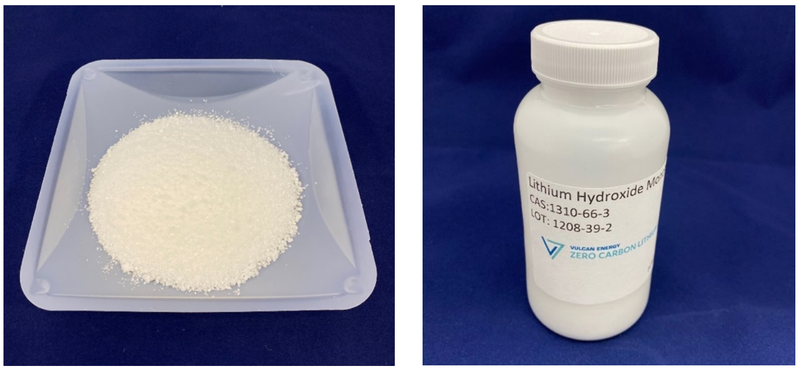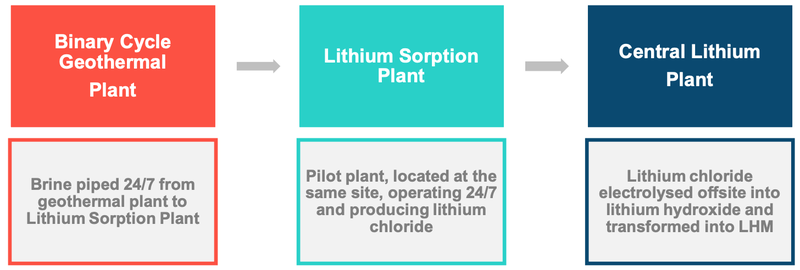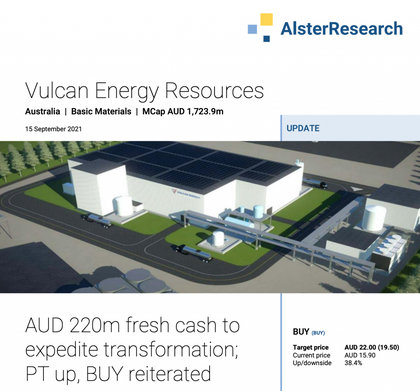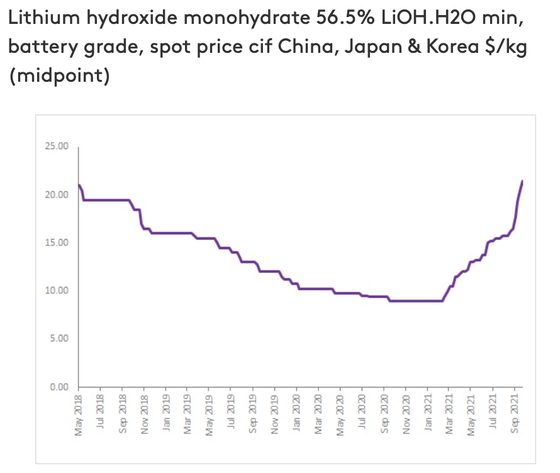VUL Produces First Battery-Grade Lithium Sample
Vulcan Energy Resources (ASX:VUL) has hit another milestone in the development of its Zero Carbon LithiumTM Project in Germany.
VUL today announced that it has produced a battery-grade lithium hydroxide monohydrate (LHM) sample that grades better than the current best-on-the-market battery grade specifications required by offtake customers.
Here it is, in all its glory:

Production of this battery quality lithium in a pilot plant in the Upper Rhine Valley is a major step on VUL’s path to producing commercial battery-grade lithium and is another step towards successful completion of the company’s Definitive Feasibility Study (DFS) that is now being conducted.
VUL is targeting Phase 1 commercial production of the battery quality material in the 2024 calendar year. In the meantime, it plans to ramp up production to supply samples to its offtake partners, which include LG Chem and Renault (and potentially Stellantis).
VUL was our Small Cap Pick of The Year for 2020 and has been the best performer to date in our Next Investors portfolio, now up more than 6500% since we first invested.
Consistent progress by the company towards its goal of delivering the world’s first Zero Carbon battery grade lithium product prompted us to make multiple investments in the company after first investing in February 2020.
Located in Germany’s Upper Rhine Valley, VUL’s has Europe’s largest JORC lithium resource, right in the heart of Europe’s auto and EV battery industry – the fastest growing lithium market in the world.
VUL produces battery grade lithium
As mentioned, VUL today announced that its chemical engineering team has successfully produced its first battery quality lithium hydroxide monohydrate (LHM) from a sorption pilot plant at a geothermal renewable energy plant in the Upper Rhine Valley.
We liked that the quality of the sample produced exceeds that of traditional battery grade LHM product, including the best on the market battery grade specifications required from offtake customers. The product graded greater than 56.5% lithium hydroxide monohydrate, or “LiOH.H2O”, and had very low impurities.
As will be the case with VUL’s planned commercial Zero Carbon LithiumTM Project, the lithium hydroxide in the pilot was produced using downstream electrolysis offsite.
The lithium chloride extracted by the sorbent was recovered with water and sent offsite where it was purified and concentrated by a third-party provider to prepare it for electrolysis to produce lithium hydroxide solution. The solution was then crystalized to produce battery grade LHM.

Now that the initial pilot was a success, VUL will ramp up production of the battery quality material in order to supply samples to its offtake partners.
From there, VUL is targeting Phase 1 commercial production in the 2024 calendar year.
Data generated while producing the sample will be used in VUL’s Definitive Feasibility Study (DFS) that is now being carried out by international lithium plant engineering specialist Hatch Ltd and VUL’s engineering teams.
VUL’s pilot has been operating successfully since April 2021, using brine from a geothermal plant, and it will be progressively scaled up in size during the coming year.
Managing Director, Dr Francis Wedin said that VUL continues to methodically progress, de-risk and execute on its plan to build a fully integrated renewable energy and battery-quality lithium chemicals project in Europe to service the battery and electric vehicle industry.
As it stands today, the project will be the first raw materials project with net zero greenhouse gas emissions in the world.
This is a significant step for the wider industry, as it demonstrates what can be achieved as global economies wok to combat climate change in the lead up to lead up to COP26 — the 26th United Nations Climate Change Conference — that is scheduled to be held later this year.
The potential for VUL to produce and supply much needed battery grade lithium to Europe’s growing number of battery plants and EV makers, with zero carbon cost, makes the stock particularly attractive to major institutional investors.
This was reflected in the recently completed share Placement to institutional investors led by Goldman Sachs and Canaccord.
VUL raised $200M in the Placement at $13.50/share and saw participation from new ESG-focused institutional shareholders as well as existing shareholders, including further investment from Gina Rinehart’s Hancock Prospecting.
Those new $13.50 shares hit the market on 22 September, resulting in the share price pulling back to below the Placement price... as often happens. But that’s good news for anyone buying on market with the stock now trading at ~$13.40 — cheaper than where institutions got in.
For existing retail shareholders, VUL has opened a share purchase plan (SPP) to raise a further $20M. The SPP will also be priced at $13.50 per share – the same price as the institutional raise – and each shareholder can subscribe for up to A$30,000 worth of new shares. The SPP will close at 5pm AEST on Wednesday, 13 October 2021.
VUL plans to use the funds to accelerate and expand its dual renewable energy and lithium development strategy. This will include acquiring existing brownfield energy and brine infrastructure to expand its operations, so that VUL isn’t limited to just its Upper Rhine Valley project.
AlsterResearch lifts target price, again
VUL, at its current share price and SPP price, looks even more attractive today when the latest analyst report from AlsterResearch is considered. The German research house has a price target of $22/share — a 65% premium to Friday’s closing price.
The details can be found in its latest report here:

In summary, Alster says:
“Vulcan Energy provides a rare opportunity to benefit from the strongly growing lithium growth trajectory and, by the same token, to participate in a project directly located in Germany, a heartland of automotive industry.”
Rising Li price lifts project economics
The lithium hydroxide spot price is now priced at more than US$20,000/tonne and looks like it wants to continue its upward trajectory. This certainly bodes well for VUL which already has buyers lined up for its premium priced battery-grade lithium hydroxide product.

That’s well above the US$14,925/t price that was in January’s Pre-Feasibility Study (PFS). At that price, a project valuation of €2.25 billion (that’s A$3.55BN) was calculated.
So the current price of ~US$20,000/tonne substantially lifts the project valuation. That also doesn’t account for any premium to be paid for the product being net Zero Carbon.
We made some calculations as to the value of VUL’s recent offtake agreements — confirmed with Renault and LG Chem — using a $15,000/t lithium hydroxide price. At that price, we determined that the 5-year Renault deal would bring in roughly US$90M to US$255M each year. And we thought that the LG Chem offtake for 10,000 tonnes would be worth ~US$150M per year to VUL.
There is no formal market for lithium so pricing can lack transparency. But according to independent commodity price assessor, S&P Global Platts, on Sept 8 lithium hydroxide priced at ~$20,000/mt. At these prices, we can increase our projected offtake revenue figures by around one third. (There’s also the suspected MoU with auto giant Stellantis still to keep in mind).
The demand for battery-grade lithium looks like it will go from strength to strength in the years ahead.
While Europe has clearly been leading the way for some time now, in the lead up to the COP26 that will be held from 1-12 November, both China and the US have made significant commitments to fighting climate change.
Global warming was a focus at the recent United Nations General Assembly (UNGA), where China announced a new commitment to tackle global warming. President Xi said that China will step up its support for other developing countries in developing green and low-carbon energy and it will not build new coal-fired power projects abroad — following similar commitments from Japan and Korea.
The US, meanwhile, said it will double its contribution to US$11.4 billion (A$15.7B) annually to support climate action in developing nations. This comes as a key, but lagging section of the Paris Climate Accords has been mobilising US$100 billion (A$137B) to countries hardest hit by global warming.
Even Australia appears to now be getting on board, last week publicly committing to a net zero emission target “preferably” by 2050.
Zero Carbon Lithium Project Milestones
✅ Acquisition of disruptive EU focussed Zero Carbon Lithium Project
✅ Commencement of Scoping Study
✅ Reports Lithium Grades above expectation
✅ Maiden Indicated Resource Reported
✅ Positive Scoping Study
✅ Test Work Shows Excellent Lithium Recoveries
✅ Taro Licence Granted
✅ Positive Pre-Feasibility Study (1), (2)
✅ Collaboration with DuPont
✅ CO2 Traceability Agreement
✅ Bankable feasibility advisor appointed - BNP Paribas
🔲 Ramp up of DLE pilot plant
✅ Offtake Agreement 1: EV battery Maker LG
✅ Offtake Agreement 2: Renault
🔲 Offtake Agreement 3
✅ [NEW] First Production of Battery Grade Lithium
🔄 Definitive Feasibility Study
🔲 Bankable Feasibility Study Complete
🔲 Project Financing Secured
Investment Milestones for VUL
✅ Initial Investment: @20c
✅ Increase Investment: @40c
✅ Increase Investment: @$6.50
✅ Price increases 500% from initial entry
✅ Price increases 1000% from initial entry
✅ Price increases 2000% from initial entry
✅ 12 Month Capital Gain Discount
✅ Free Carry
✅ Take Profit
🔲 Hold remaining Position for next 2+ years
General Information Only
This material has been prepared by StocksDigital. StocksDigital is an authorised representative (CAR 000433913) of 62 Consulting Pty Limited (ABN 88 664 809 303) (AFSL 548573).
This material is general advice only and is not an offer for the purchase or sale of any financial product or service. The material is not intended to provide you with personal financial or tax advice and does not take into account your personal objectives, financial situation or needs. Although we believe that the material is correct, no warranty of accuracy, reliability or completeness is given, except for liability under statute which cannot be excluded. Please note that past performance may not be indicative of future performance and that no guarantee of performance, the return of capital or a particular rate of return is given by 62C, StocksDigital, any of their related body corporates or any other person. To the maximum extent possible, 62C, StocksDigital, their related body corporates or any other person do not accept any liability for any statement in this material.
Conflicts of Interest Notice
S3 and its associated entities may hold investments in companies featured in its articles, including through being paid in the securities of the companies we provide commentary on. We disclose the securities held in relation to a particular company that we provide commentary on. Refer to our Disclosure Policy for information on our self-imposed trading blackouts, hold conditions and de-risking (sell conditions) which seek to mitigate against any potential conflicts of interest.
Publication Notice and Disclaimer
The information contained in this article is current as at the publication date. At the time of publishing, the information contained in this article is based on sources which are available in the public domain that we consider to be reliable, and our own analysis of those sources. The views of the author may not reflect the views of the AFSL holder. Any decision by you to purchase securities in the companies featured in this article should be done so after you have sought your own independent professional advice regarding this information and made your own inquiries as to the validity of any information in this article.
Any forward-looking statements contained in this article are not guarantees or predictions of future performance, and involve known and unknown risks, uncertainties and other factors, many of which are beyond our control, and which may cause actual results or performance of companies featured to differ materially from those expressed in the statements contained in this article. S3 cannot and does not give any assurance that the results or performance expressed or implied by any forward-looking statements contained in this article will actually occur and readers are cautioned not to put undue reliance on forward-looking statements.
This article may include references to our past investing performance. Past performance is not a reliable indicator of our future investing performance.

